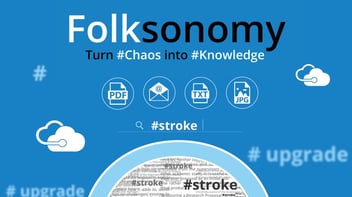Text analytics systems allow organizations to discover valuable information hidden in unstructured data, mainly text.
Data analytics technologies have evolved so much that they are now capable of processing information in textual format thanks to artificial intelligence. Text analytics tools are becoming essential. Discover what text analytics is through 5 real examples.

Artificial intelligence is undoubtedly one of the most important technologies of the 21st century and its constant development never ceases to surprise with new possibilities that promise to change the world as we know it in the future.
Some of the uses of artificial intelligence are well known: machine learning, intelligent algorithms, voice recognition systems, predictive analytics, etc.
However, other applications of AI go more unnoticed. There are many examples of amazing AI-driven projects, but this time we focus on text analytics.
Text analytics systems have gained relevance as the amount of information to be processed has multiplied. Nowadays, companies or organizations need to be able to process data beyond the usual formats, including data in text format written in the language humans use to communicate.
What is text analytics?
Text analytics technologies are capable of processing data in unstructured format —specifically in written text format—. In other words, text analytics systems have the ability to extract quality information from any type of text.
This type of technology is part of artificial intelligence and uses algorithms that are capable of finding patterns in unstructured texts.
This capability is extremely important, since it is estimated that 80% of the information relevant to organizations is hidden in unstructured data, usually texts.
The good news is that there are many text analytics systems available today. However, not all of them have the same capabilities or serve the same purpose. This is why it is so important to understand how these technologies work and how they differ. In general, text analytics systems work based on one of two methods: taxonomy or folksonomy. The main difference between the two is that taxonomy requires a previous organization of the information through predetermined tags in order to classify the content, while folksonomy is based on natural language tagging.
Below we list some of the most common applications of text analytics.
What are text analytics systems for? 5 real examples of text analytics
1. Hashtag #text analytics

One of the simplest and most easily recognized examples of text analytics are user-generated hashtags.
It is very likely that in your daily life you use hashtags on social networks, blogs or other digital platforms to tag content. Well, this practice is part of taxonomy. Users create tags that are recognized by a text analytics algorithm that organizes and classifies content based on the tag; be it text, photos, videos or any type of content.
2. Google

Google is the world's most widely used content search engine. Its search algorithms not only find any type of content based on a word or sentence typed by a user in any language, but also rank the order of the content based on multiple parameters.
Google analytics algorithms are not only capable of recognizing text written directly on a website, but also recognize and process text written in files, videos, documents, images, etc.
3. Flickr
Flickr is one of the most popular and important platforms for sharing photographs and also one of the first websites that implemented a text analytics system based on folksonomy.
On the platform, users of the Flickr community upload their photos and describe the content of their work through tags. In addition, other users can add more tags to the photographs even if they are not the authors of the photograph and can even tag the location of the place where the photograph was taken.
In short, the portal uses text analytics to organize information and make it easier for users to find the images they are looking for. Flickr's text analytics algorithm also has the ability to recognize trends and highlight the most relevant hashtags of the moment.
4. Folksonomy Text Analytics
At Bismart we have our own text analytics solution based on folksonomy. Bismart Folksonomy Text Analytics is an AI-based technology that is capable of processing and recognizing patterns and trends in any type of text.
Folksonomy Text Analytics has been mainly applied in the healthcare and clinical research sector. In the medical field, professionals generate huge amounts of data every day: medical records, prescribed medication, presenting symptoms, admissions and releases, etc.
All this information is extremely valuable when it comes to conducting medical research and drawing conclusions regarding the response of patients to a specific treatment or the evolution of a disease that is still unknown or without definitive treatment, as happened with Covid-19.
The problem is that this information is not only generated in textual format, but also that each professional writes it in his or her own way, without following any kind of pattern when writing, for example, the symptoms of a patient. In other words, the information is not structured. In addition, the magnitude of the information generated is such that it is practically impossible to classify this information manually.
Folksonomy Text Analytics is a software based on Large Language Models (LLM), a technology that allows processing large amounts of data in textual format and extracting relevant information from them. This technology is based on algorithms capable of finding patterns in unstructured text, which is extremely valuable considering that 80% of the relevant information for organisations is in this format. Bismart Folksonomy Text Analytics is one of the solutions that use this technology and has been successfully applied in the healthcare and clinical research sector, allowing large amounts of information to be classified for subsequent analysis.
The great advantage of Bismart Folksonomy Text Analytics is that instead of finding patterns in the information based on previously established tags, the system itself generates the tags based on the frequency of their appearance in the text.
Bismart Folksonomy Text Analytics has been used by renowned medical institutions such as Institut Català de la Salut, Hospital del Mar, Laboratorios Ferrer and many more. Discover all the details of this solution on the product page:
5. Search Engine Optimization (SEO)

Another of the most common uses of text analytics systems is in SEO analytic tools that, among other things, analyze the positioning of a web page based on content tags, description, title, etc.
Among many other things, SEO analytics platforms recognize patterns in textual data and, in fact, text is the main positioning format in the case of Search Engine Optimization.
Conclusion
Considering that 80% of the valuable information for organizations is in unstructured format and mainly in textual format, text analytics systems are highly valuable for uncovering hidden information that, without this type of technology, would be impossible to access.



